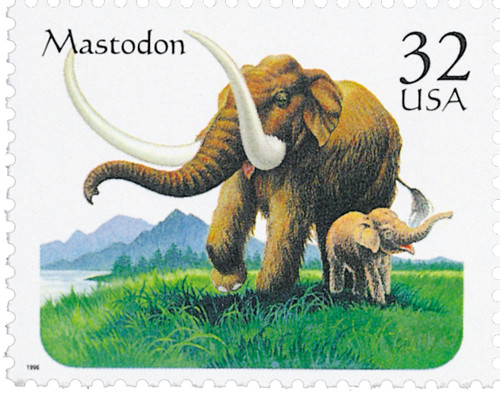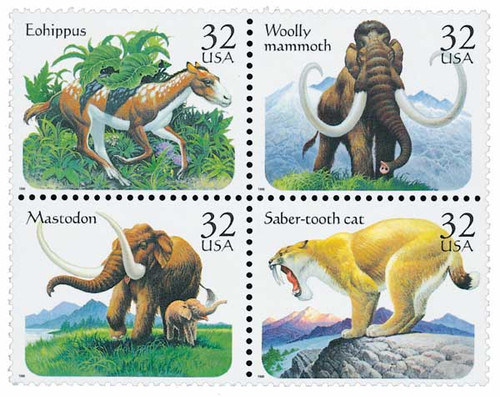
# 3079 - 1996 32c Prehistoric Animals: Mastodon
US #3079
1996 Mastodon
- Part of set of four picturing Prehistoric Animals
- Issued in semi-jumbo size
- Designed to appeal to young stamp collectors
Stamp Category: Commemorative
Set: Prehistoric Animals
Value: 32¢, First-class mail rate
First Day of Issue: June 8, 1996
First Day City: Toronto, Ontario, Canada
Quantity Issued: 27,772,500
Printed by: Ashton-Potter (USA) Ltd.
Printing Method: Lithographed
Format: Panes of 20 (4 across, 5 down) from plates of 120 (8 across, 15 down)
Perforations: 11.1 x 10.9
Why the stamp was issued: The four Prehistoric Animals stamps were issued to appeal to young stamp collectors. Ancient animals, such as these mammals, appeal to children. It was hoped, these stamps would spark an interest in stamp collecting that would last a lifetime.
About the stamp design: Davis Meltzer created the acrylic paintings used for these stamps. He referred to paintings by Charles Knight, who had painted many historic animals for the Museum of Natural History in New York City, as well as other sources. Dr. John Flynn, a prehistoric animal specialist with the Field Museum in Chicago was consulted after Meltzer’s paintings were complete to assure accuracy.
This set depicts the Eohippus, Woolly mammoth, Mastodon, and Saber-tooth cat.
Special design details: The Eohippus was much smaller than the other animals shown, so it was enlarged in comparison to fill the stamp space.
About the printing process: The stamps were originally intended to be printed using offset lithography and intaglio engraving. Printer Ashton-Potter was using a new press in 1995 when they tried to produce these stamps, and had issues with proper registration. The stamps were put on hold for a year. It was then decided they would be printed using only lithography.
First Day City: The Prehistoric Animals stamps were dedicated on the first day of Capex 96, held in Toronto, Canada. The sales of the stamps and First Day of Issue cancellations were handled by the Buffalo, New York, post office.
The stamps were originally scheduled to be issued at the American Philatelic Society’s annual convention but were delayed because of “technical problems with the printing process,” according to the USPS.
About the Prehistoric Animals set: This set shows four animals who roamed the ancient earth. Each one is an ancestor to modern animals. The fossil record gives scientists clues to what these creatures looked like and how they lived many years ago.
History the stamp represents:
Mastodons were animals very much like modern elephants. The fossil record shows that mastodons first appeared in northern Africa. From there they spread all over Europe, Asia, and the rest of Africa. The mastodons later arrived in the New World.
Mastodons were related to another extinct, elephant-like species, the four-tuskers. Both of these creatures were shorter and stockier than modern elephants. Like four-tuskers, early types of mastodons had tusks on both their lower and upper jaw, but many later examples of the species no longer had this trait. Some types of mastodons and four-tuskers had prominent lower tusks which were very flat. These animals are called shovel-tuskers. All mastodons were covered with reddish brown hair, and had teeth that were much smaller than those of elephants.
By 10,000 years ago, most mastodons had disappeared. However, evidence indicates that the mastodon existed in North America after the Pleistocene – which means they would have co-existed with historic Native American groups. Mankind was probably a factor in the mastodon’s extinction, especially in North America.
US #3079
1996 Mastodon
- Part of set of four picturing Prehistoric Animals
- Issued in semi-jumbo size
- Designed to appeal to young stamp collectors
Stamp Category: Commemorative
Set: Prehistoric Animals
Value: 32¢, First-class mail rate
First Day of Issue: June 8, 1996
First Day City: Toronto, Ontario, Canada
Quantity Issued: 27,772,500
Printed by: Ashton-Potter (USA) Ltd.
Printing Method: Lithographed
Format: Panes of 20 (4 across, 5 down) from plates of 120 (8 across, 15 down)
Perforations: 11.1 x 10.9
Why the stamp was issued: The four Prehistoric Animals stamps were issued to appeal to young stamp collectors. Ancient animals, such as these mammals, appeal to children. It was hoped, these stamps would spark an interest in stamp collecting that would last a lifetime.
About the stamp design: Davis Meltzer created the acrylic paintings used for these stamps. He referred to paintings by Charles Knight, who had painted many historic animals for the Museum of Natural History in New York City, as well as other sources. Dr. John Flynn, a prehistoric animal specialist with the Field Museum in Chicago was consulted after Meltzer’s paintings were complete to assure accuracy.
This set depicts the Eohippus, Woolly mammoth, Mastodon, and Saber-tooth cat.
Special design details: The Eohippus was much smaller than the other animals shown, so it was enlarged in comparison to fill the stamp space.
About the printing process: The stamps were originally intended to be printed using offset lithography and intaglio engraving. Printer Ashton-Potter was using a new press in 1995 when they tried to produce these stamps, and had issues with proper registration. The stamps were put on hold for a year. It was then decided they would be printed using only lithography.
First Day City: The Prehistoric Animals stamps were dedicated on the first day of Capex 96, held in Toronto, Canada. The sales of the stamps and First Day of Issue cancellations were handled by the Buffalo, New York, post office.
The stamps were originally scheduled to be issued at the American Philatelic Society’s annual convention but were delayed because of “technical problems with the printing process,” according to the USPS.
About the Prehistoric Animals set: This set shows four animals who roamed the ancient earth. Each one is an ancestor to modern animals. The fossil record gives scientists clues to what these creatures looked like and how they lived many years ago.
History the stamp represents:
Mastodons were animals very much like modern elephants. The fossil record shows that mastodons first appeared in northern Africa. From there they spread all over Europe, Asia, and the rest of Africa. The mastodons later arrived in the New World.
Mastodons were related to another extinct, elephant-like species, the four-tuskers. Both of these creatures were shorter and stockier than modern elephants. Like four-tuskers, early types of mastodons had tusks on both their lower and upper jaw, but many later examples of the species no longer had this trait. Some types of mastodons and four-tuskers had prominent lower tusks which were very flat. These animals are called shovel-tuskers. All mastodons were covered with reddish brown hair, and had teeth that were much smaller than those of elephants.
By 10,000 years ago, most mastodons had disappeared. However, evidence indicates that the mastodon existed in North America after the Pleistocene – which means they would have co-existed with historic Native American groups. Mankind was probably a factor in the mastodon’s extinction, especially in North America.












